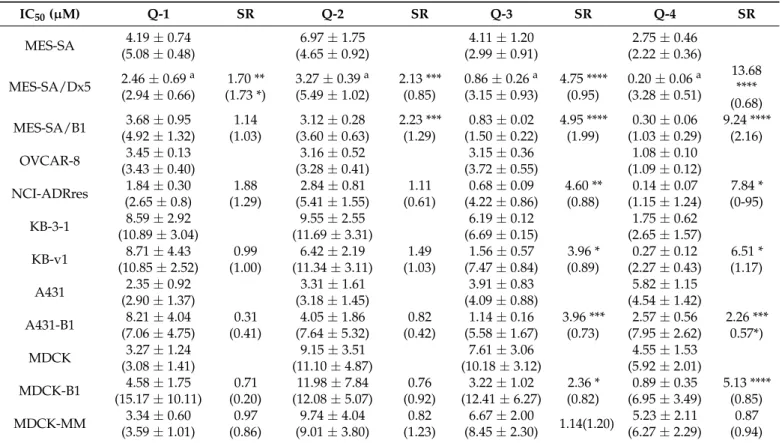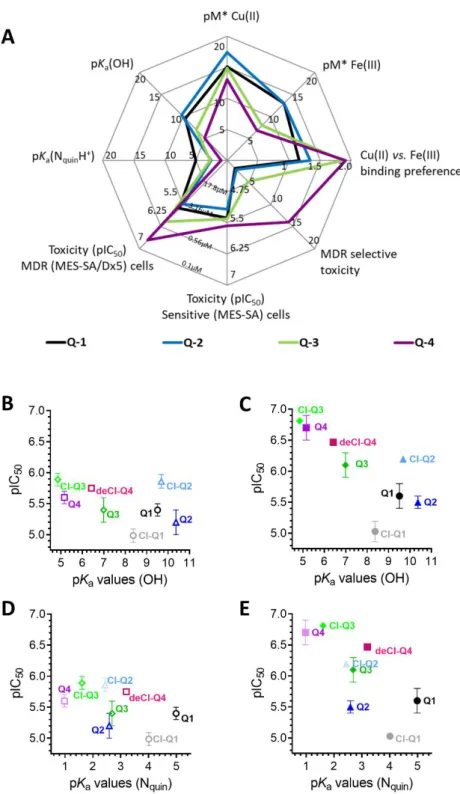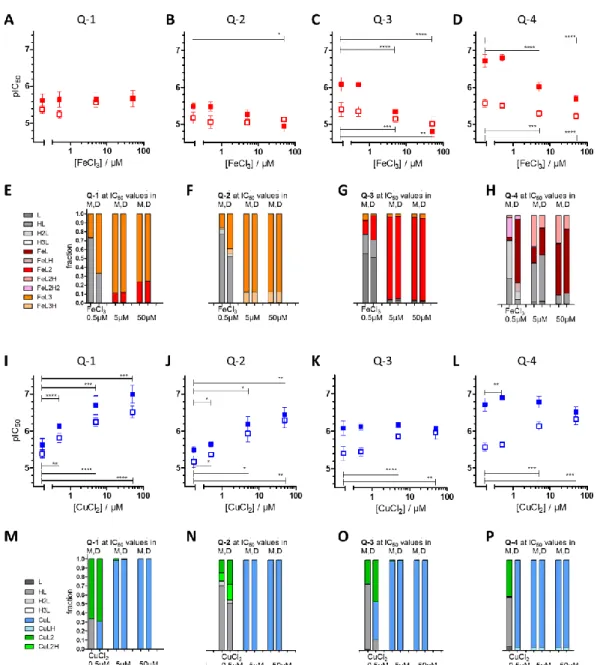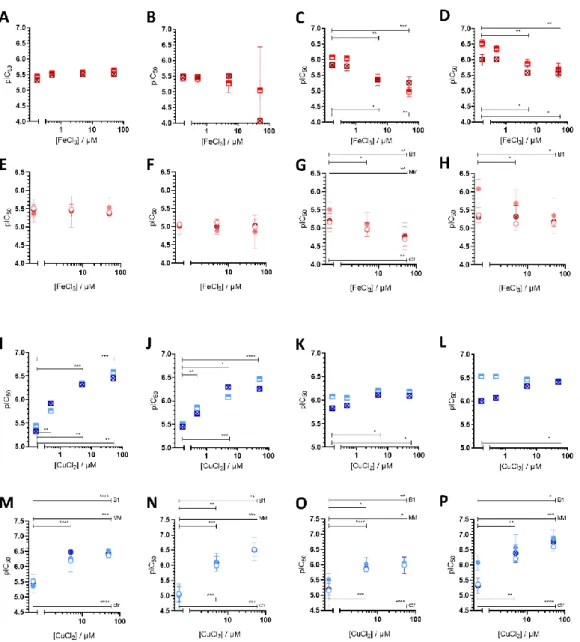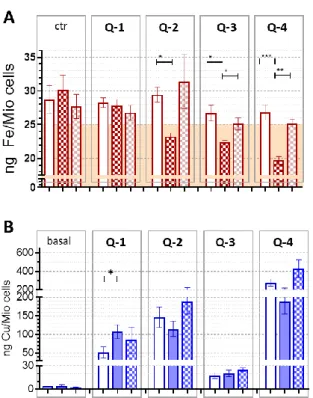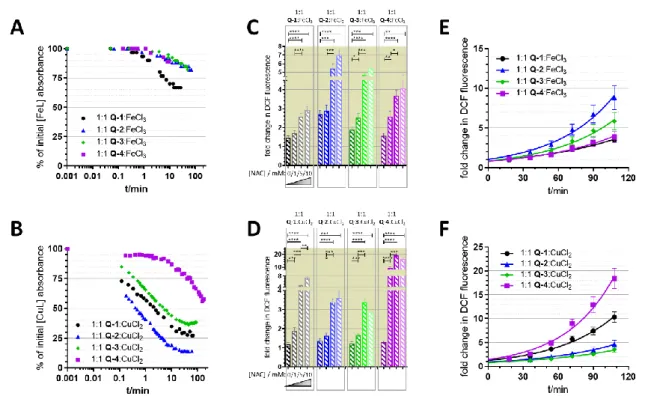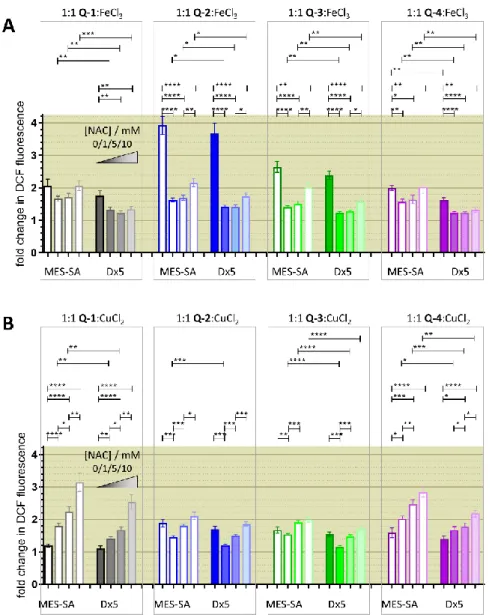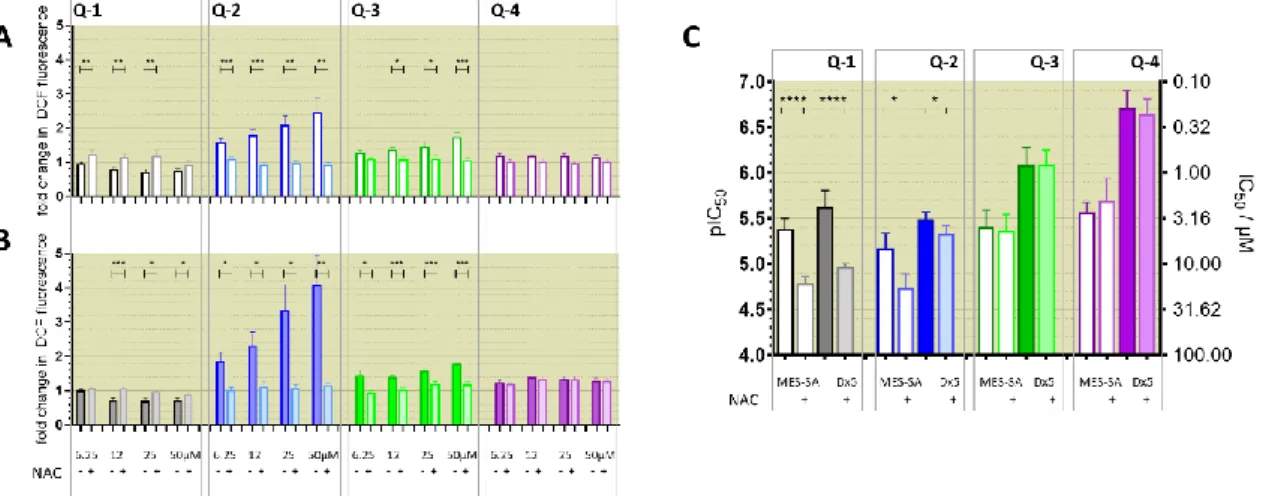cancers
Article
Relation of Metal-Binding Property and Selective Toxicity of 8-Hydroxyquinoline Derived Mannich Bases Targeting
Multidrug Resistant Cancer Cells
Veronika F.S. Pape1,† , AnikóGaál1,2, István Szatmári3 , Nóra Kucsma1, Norbert Szoboszlai2, Christina Streli4, Ferenc Fülöp3 ,Éva A. Enyedy5,6,* and Gergely Szakács1,7,*
Citation:Pape, V.F.S.; Gaál, A.;
Szatmári, I.; Kucsma, N.; Szoboszlai, N.; Streli, C.; Fülöp, F.; Enyedy, É.A.;
Szakács, G. Relation of Metal-Binding Property and Selective Toxicity of 8-Hydroxyquinoline Derived Mannich Bases Targeting Multidrug Resistant Cancer Cells.Cancers2021, 13, 154. https://doi.org/10.3390/
cancers13010154
Received: 7 October 2020 Accepted: 24 December 2020 Published: 5 January 2021
Publisher’s Note: MDPI stays neu- tral with regard to jurisdictional clai- ms in published maps and institutio- nal affiliations.
Copyright:© 2021 by the authors. Li- censee MDPI, Basel, Switzerland.
This article is an open access article distributed under the terms and con- ditions of the Creative Commons At- tribution (CC BY) license (https://
creativecommons.org/licenses/by/
4.0/).
1 Institute of Enzymology, Research Centre for Natural Sciences, Hungarian Academy of Sciences, Magyar Tudósok körútja 2, H-1117 Budapest, Hungary; veronika.pape@med.semmelweis-univ.hu (V.F.S.P.);
anikgaal@gmail.com (A.G.); kucsma.nora@ttk.mta.hu (N.K.)
2 Institute of Chemistry, Eötvös Loránd University, Pázmány Péter sétány 1/A, H-1117 Budapest, Hungary;
szobosz@chem.elte.hu
3 Institute of Pharmaceutical Chemistry and Stereochemistry Research Group of Hungarian Academy of Sciences, University of Szeged, Eötvös u. 6, H-6720 Szeged, Hungary; szatmari.istvan@szte.hu or szatmari.istvan@pharm.u-szeged.hu (I.S.); fulop@pharm.u-szeged.hu (F.F.)
4 Institute of Atomic and Subatomic Physics, Technical University Vienna, Stadionallee 2, A-1020 Vienna, Austria; streli@ati.ac.at
5 Department of Inorganic and Analytical Chemistry, Interdisciplinary Excellence Centre, University of Szeged, Dóm tér 7, H-6720 Szeged, Hungary
6 MTA-SZTE Lendület Functional Metal Complexes Research Group, University of Szeged, Dóm tér 7, H-6720 Szeged, Hungary
7 Institute of Cancer Research, Medical University of Vienna, Borschkegasse 8a, A-1090 Vienna, Austria
* Correspondence: enyedy@chem.u-szeged.hu (É.A.E.); szakacs.gergely@ttk.mta.hu or gergely.szakacs@meduniwien.ac.at (G.S.); Tel./Fax: +361-382-6715 (G.S.)
† Present address: Department of Physiology, Faculty of Medicine, Semmelweis University, T ˝uzoltóutca 37-47, H-1094 Budapest, Hungary.
Simple Summary: Effective treatment of cancer is often limited by the resistance of cancer cells to chemotherapy. A well-described mechanism supporting multidrug resistance (MDR) relies on the efflux of toxic drugs from cancer cells, mediated by P-glycoprotein (Pgp). Circumventing Pgp-mediated resistance is expected to make a significant contribution to improved therapy of malignancies. Interestingly, MDR cells exhibit paradoxical hypersensitivity towards a diverse set of anticancer chelators. In this study we explore the relation of chemical and structural properties influencing metal binding and toxicity of a set of 8-hydroxyquinoline derivatives to reveal key characteristics governing “MDR-selective” activity. We find that subtle changes in the stability and redox activity of the biologically relevant metal complexes significantly influence MDR-selective toxicity. Our results underline the importance of chelation in MDR-selective toxicity, suggesting that the collateral sensitivity of MDR cells may be targeted by preferential iron deprivation or the formation of redox-active copper(II) complexes.
Abstract:Resistance to chemotherapeutic agents is a major obstacle in cancer treatment. A recently proposed strategy is to target the collateral sensitivity of multidrug resistant (MDR) cancer. Para- doxically, the toxicity of certain metal chelating agents is increased, rather than decreased, by the function of P-glycoprotein (Pgp), which is known to confer resistance by effluxing chemotherapeutic compounds from cancer cells. We have recently characterized and compared the solution’s chemical properties including ligand protonation and the metal binding properties of a set of structurally related 8-hydroxyquinoline derived Mannich bases. Here we characterize the impact of the solution stability and redox activity of their iron(III) and copper(II) complexes on MDR-selective toxicity.
Our results show that the MDR-selective anticancer activity of the studied 8-hydroxyquinoline derived Mannich bases is associated with the iron deprivation of MDR cells and the preferential formation of redox-active copper(II) complexes, which undergo intracellular redox-cycling to induce oxidative stress.
Cancers2021,13, 154. https://doi.org/10.3390/cancers13010154 https://www.mdpi.com/journal/cancers
Cancers2021,13, 154 2 of 24
Keywords:cancer; multidrug resistance; reactive oxygen species; metal-based drugs; collateral sensi- tivity
1. Introduction
Despite the diversity of drugs used for the treatment of cancer, resistance is a frequent reason for the failure of cancer chemotherapy [1]. Cells that are resistant to a single cytotoxic agent can develop cross-resistance to further structurally and mechanistically unrelated drugs, leading to the phenotype of multidrug resistance (MDR) [2,3]. A well-described mechanism supporting MDR relies on the energy dependent efflux of drugs, resulting in decreased intracellular drug accumulation. Active transport is mediated by ATP-binding- cassette (ABC) proteins, and in particular P-glycoprotein (Pgp, encoded by the ABCB1 gene), which confers resistance to a wide variety of compounds [2,4–8]. Unfortunately, clinical translation of in vitro MDR transporter inhibition proved unsuccessful [7,9–13]. As circumventing Pgp-mediated resistance is expected to make a significant contribution to improved therapy of malignancies, alternative strategies to inhibit, bypass or even exploit efflux-based resistance mechanisms are needed [4,14].
A possible approach to overcome Pgp-mediated MDR exploits cellular vulnerabilities that occur as a result of the adaption to cytotoxic stress. Interestingly, Pgp-expressing MDR cells exhibit paradoxical hypersensitivity towards a diverse set of compounds identified in the Developmental Therapeutics Program of the National Cancer Institute (NCI-DTP) database [15–21]. In several in vitro models, increased sensitivity of otherwise multidrug resistant cells to the so-called “MDR-selective” compounds was abrogated in the presence of transporter inhibitors, indicating that the activity of Pgp is both necessary and sufficient to confer collateral sensitivity [15,19,20,22]. MDR-selective compounds are enriched in metal chelating ligands [15,19], suggesting that interaction with endogenous metal ions may be fundamental to their mechanism of action. We and others have identified several isatin- β-thiosemicarbazones [15,23–25], 1,10-phenanthrolines [15,19,26] and 8-hydroxyquinoline derivatives [15,19] with MDR-selective activity, but the molecular determinants of their MDR-selective toxicity have remained elusive. Collateral sensitivity of MDR cells has been associated with preferential ATP depletion resulting from the futile cycling of the Pgp ATPase [16,27–32], a differential sensitivity to reactive oxygen species (ROS) [16,18,33], or an increased lysosomal accumulation of compounds [34–36]. In view of the metal complex formation ability of the MDR-selective compounds, mechanisms responsible for the toxicity of anticancer chelators deserve special attention. Our earlier work has focused on the role of intracellularly formed complexes in the mechanism of MDR-selective toxicity. In that respect, characterization of solution speciation, the relation of complex equilibria and redox properties to cytotoxic activity, revealed key characteristics governing complex formation and anticancer activity [37–41]. Recently, we have shown that the MDR- selective toxicity of NSC297366 is linked to cellular iron depletion, which is exacerbated by Pgp [42]. Due to their increased proliferation, cancer cells have an excessive demand for iron [43,44] and copper [45,46], and this vulnerability can be exploited by chelator-based cancer treatment strategies [37,39,47–49]. The anticancer activity of chelators is explained by the perturbation of the intracellular metal homeostasis, which results either in the depletion of essential metal ions [48,49], or the shuttling of excess metal ions into cellular organelles such as mitochondria [50]. Additionally, metal-binding compounds can influence the activity of various metalloenzymes. Ribonucleotide reductase (RR), which catalyzes the rate limiting step in DNA synthesis, is a well characterized target of anticancer compounds of the thiosemicarbazone class such as Triapine [51–54]. Anticancer thiosemicarbazones possessing strong metal complex formation abilities were also described as inducing apoptosis by modulating the expression of Bax and Bcl-2 proteins [55,56]. Furthermore, they can cause cell cycle arrest (e.g., by downregulation of Cyclin D1), and inhibit tumor growth through the upregulation of tumor and metastasis suppressors [44,48]. Finally,
Cancers2021,13, 154 3 of 24
metal complexes may possess biological activity themselves, partly due to their redox activity [57–59].
Interestingly, not every chelator possesses MDR-selective toxicity. Recently, we have characterized the copper(II) and iron(III) binding properties of a set of 8-hydroxyquinoline derived Mannich bases [60]. Since these structurally related analogs possess variable levels of MDR-selective toxicity, our aim here was to understand the relation of chemical and structural properties influencing metal binding to MDR-selective toxicity.
2. Materials and Methods 2.1. Chemicals
8-Hydroxyquinoline (Q-1), 20,70-dichlorofluorescein diacetate (DCFDA), CuCl2, FeCl3, NaOH stock solutions, dimethyl sulfoxide (DMSO), and human holo-transferrin were purchased from Sigma-Aldrich, N-acetyl cysteine (NAC) was purchased from TCI Europe, 3-(4 5-dimethylthiazol-2-yl)-2 5-diphenyltetrazolium bromide (MTT) reagent was obtained from ABCR. Ligands morpholine 7-(morpho-lino-methyl)quinolin-8-ol (Q-2) and piperi- dine 7-(piperidin-1-ylmethyl)quinolin-8-ol (Q-3) were obtained from NCI-DTP, 5-chloro-7- ((2-fluorobenzylamino)methyl)quinolin-8-ol (Q-4) was previously synthesized [60], while De-Cl-Q-4without Chloro-substitution in R5 and non-chelating compoundsNC-2toNC-4 were synthesized and characterized in this work. Details of the synthetic process and the characterization of the compounds are shown in the supplement. Samples containing the respective ligands and the metal salt (CuCl2or FeCl3) at constant metal-to-ligand ratios were prepared as 10 mM stock solutions in an 80%–87% DMSO-water mixture (depending on the metal-to-ligand ratio), by deprotonating the ligand (diluted from a 50 mM to 100 mM DMSO stock) with one equivalent of NaOH and adding the appropriate amount of metal salt stock solutions (100 mM) to obtain the desired metal-to-ligand ratios (1:1, 1:2 or 1:3).
2.2. Cell Culture
MDCK II canine kidney cells, A431 epidermoid carcinoma cells, the human uterine sarcoma cell lines MES-SA and the doxorubicin selected MES-SA-Dx5 were obtained from ATCC (MDCK II: No. CRL-2936™, A431: No. CRL-1555™, MES-SA: No. CRL- 1976™, MES-SA/Dx5: No. CRL-1977™). ABCB1 was expressed in A431 and MES-SA cells using lentiviral transduction [42,61]. The human cervix carcinoma cell line KB-3-1 and the vinblastine selected KB-v1were kind gifts from Dr. Michael M. Gottesman, National Institutes of Health. The phenotype of the resistant cells was verified using cytotoxicity assays. MDCK-B1 and MDCK-MM were established by the Sleeping Beauty transposon- based gene delivery system [37,62]. OVCAR-8 and NCI-ADRres cells (obtained from the Division of Cancer Treatment and Diagnosis (DCTD) Tumor Repository (National Cancer Institute, Frederick, MD, USA)) were cultivated in RPMI-1640 (Sigma Aldrich, Budapest, Hungary), and other cell lines were cultivated in Dulbecco’s Modified Eagle Medium (DMEM, Sigma Aldrich, Budapest, Hungary), supplemented with 10% fetal bovine serum, 5 mM glutamine, and 50 unit/mL penicillin and streptomycin (Life Technologies, Carlsbad, CA, USA). All cell lines were cultivated at 37◦C, 5% CO2.
2.3. MTT Viability Assay
MTT viability assays were performed as described earlier with minor modifica- tions [37,63,64]. Briefly, cells were seeded into 96-well tissue culture plates (Sarstedt, Newton, NC, USA/Orange, Braine-l’Alleud, Belgium) at a density of 5000 cells/well and allowed to attach overnight. Test compounds were added to achieve the required final concentration in a final volume of 100µL per well. After an incubation period of 72 h, the supernatant was removed and fresh medium containing the MTT reagent (0.083 mg/mL) was added. Incubation with MTT at 37◦C was terminated after 1 h by removing the super- natant and lysing the cells with 100µL DMSO per well. Viability of the cells was measured spectrophotometrically based on the absorbance values at 540 nm using either a Perkin Elmer Victor X3 or an EnSpire microplate reader. Data were background corrected by
Cancers2021,13, 154 4 of 24
subtraction of the signal obtained from unstained cell lysates and normalized to untreated cells. Curves were fitted by Prism software (GraphPad Software Inc., San Diego, CA, USA) using the sigmoidal dose-response model (comparing variable and fixed slopes). Curve fit statistics were used to determine the concentration of test compound that resulted in 50% toxicity (IC50). Significance was calculated using unpairedt-tests; results are given as
*:p≤0.05, **:p≤0.01, ***:p≤0.001, ****:p≤0.0001.
2.4. Total-Reflection X-ray Fluorescence (TXRF) Measurements
Cells were seeded to 6-well plates in a density of 1.5 Mio cells/well and allowed to attach overnight. Following a washing step with phosphate buffered saline (PBS), cells were incubated in serum free DMEM. For the iron-level measurements, cells were preloaded with 25µM holo-transferrin for 4 h and, after a washing step with serum free DMEM, cells were incubated with 5 µM of each ligand for 8 h. For the detection of copper levels, cells were treated with 1µM of the ligands in the presence of 5µM CuCl2
for 4 h. Following incubation, cells were harvested upon trypsination, washed twice with PBS, counted and the resulting pellets were digested in 20µL of 30% H2O2, 80µL of 65% HNO3. 10µL of 15µg/mL Ga(NO3)3(in nitric acid) was added as an internal standard upon digestion for 24 h at room temperature. From the resulting solutions, 2µL were pipetted on the quartz reflectors used for total-reflection X-ray fluorescence (TXRF) analysis. For the determination of the intracellular Cu content, the TXRF method was used as previously reported [65]. Briefly, all determinations were performed on an Atomika 8030C TXRF spectrometer (Atomika Instruments GmbH, Oberschleissheim, Germany). The stock solution of 1000 mg/L Ga was purchased from Merck (Darmstadt, Germany). The Kα line used for determination of Fe and Cu were at 6.403 and 8.047 keV. Applicability of TXRF for the elemental analysis of human cells has been demonstrated earlier [66]. Significance was calculated using unpairedt-tests; results are given as *: p≤0.05, **: p≤0.01, ***:
p≤0.001, ****:p≤0.0001.
2.5. Reactive Oxygen Species (ROS) Determination Using DCFDA
Measurements were performed as described earlier [37]. Briefly, cells were harvested, washed with PBS, and incubated with 10µM DCFDA in a water bath shaker at 37◦C for 30 min in a density of 3×106cells/mL. After washing with PBS, cells were seeded to 96-well plates in PBS in a density of 2×104cells/well. Following the measurement of the basal fluorescence, test compounds were added in different concentrations and the fluorescence of the samples was followed at time intervals of 10 min. DCFDA solution in buffer was used as a cell free control to test for interaction of the test compounds with DCFDA. Data were analyzed as fold change of fluorescence compared to basal levels and untreated cells. Significance was calculated using unpairedt-tests; results are given as *:
p≤0.05, **:p≤0.01, ***:p≤0.001, ****:p≤0.0001.
3. Results
In a recent study we have described the synthesis and chemical characterization of four closely related 8-hydroxyquinoline Mannich base derivatives [60]. The series contains structurally related derivatives of the unsubstituted 8-hydroxyquinoline core structure (NSC2039, Q-1), including the morpholin-1-yl-methyl derivative NSC662298 (Q-2), the piperidin-1-yl-methyl derivative NSC57969 (Q-3), andQ-4, that was inspired by its ring-closed derivative NSC297366 [19,42] (Figure S1). To assess the effect of these structural modifications on MDR-selective toxicity, herein we included several cell line pairs consisting of drug-sensitive parental and MDR derivatives. Expression of functional Pgp was verified in all MDR cells, which were also characterized for the presence of further ABC-transporters (Figure S2). As shown in Table1, the compounds possess variable levels of MDR-selective toxicity across the cell panel. Q-1is equally toxic to parental MES-SA cells and its MDR derivatives including MES-SA/Dx5 and MES-SA/B1, in which Pgp expression was increased as a result of drug selection [67–69] or viral overexpression,
Cancers2021,13, 154 5 of 24
respectively. The remaining three ligands exhibited increasing toxicity in the two MDR MES-SA derivatives, while their toxicity remained constant in the Pgp negative MES-SA cells. In particular,Q-3andQ-4showed marked preferential toxicity in MES-SA/Dx5 and MES-SA/B1 cells, which was abrogated in the presence of the Pgp inhibitor Tariquidar (TQ) (Table1, TQ data in brackets). The same trends were observed in further cell line pairs including the ovarian cancer cell lines OVCAR-8 and NCI-ADRres, the cervix carcinoma cell lines KB-3-1 and KB-v1, as well as in the epidermoid carcinoma cell line A431 and its transfected counterpart A431-B1. To further confirm the impact of Pgp on the increased toxicity against MDR cells, toxicity was assayed in MDCK cells expressing wild-type Pgp (MDCK-B1) or a non-functional variant (MDCK-MM [62]). Whereas MDCK-B1 cells were more sensitive toQ-3andQ-4, MDCK cells expressing the inactive Pgp variant did not show collateral sensitivity. These results clearly prove that the increased toxicity of the MDR-selective compoundsQ-3andQ-4is linked to the function of Pgp.
Table 1.Toxicity of the studied compounds in a panel of multidrug resistant (MDR) cell lines. IC50values (50% toxicity) are shown inµM, as determined by MTT assays performed in the absence or presence of 1µM Tariquidar (values in brackets). MDR-selective toxicity of a compound is expressed as the fraction of IC50values obtained in Pgp negative vs. positive cells (selectivity ratio, SR) determined from 3–18 independent experiments. A compound is considered to possess MDR-selectivity at SR > 2. Significance was calculated using unpairedt-tests; results are given as *:p≤0.05, **:p≤0.01, ***:p≤0.001, ****:p≤0.0001.
IC50(µM) Q-1 SR Q-2 SR Q-3 SR Q-4 SR
MES-SA 4.19±0.74
(5.08±0.48)
6.97±1.75 (4.65±0.92)
4.11±1.20 (2.99±0.91)
2.75±0.46 (2.22±0.36) MES-SA/Dx5 2.46±0.69a
(2.94±0.66)
1.70 **
(1.73 *)
3.27±0.39a (5.49±1.02)
2.13 ***
(0.85)
0.86±0.26a (3.15±0.93)
4.75 ****
(0.95)
0.20±0.06a (3.28±0.51)
13.68
****
(0.68) MES-SA/B1 3.68±0.95
(4.92±1.32)
1.14 (1.03)
3.12±0.28 (3.60±0.63)
2.23 ***
(1.29)
0.83±0.02 (1.50±0.22)
4.95 ****
(1.99)
0.30±0.06 (1.03±0.29)
9.24 ****
(2.16) OVCAR-8 3.45±0.13
(3.43±0.40)
3.16±0.52 (3.28±0.41)
3.15±0.36 (3.72±0.55)
1.08±0.10 (1.09±0.12) NCI-ADRres 1.84±0.30
(2.65±0.8)
1.88 (1.29)
2.84±0.81 (5.41±1.55)
1.11 (0.61)
0.68±0.09 (4.22±0.86)
4.60 **
(0.88)
0.14±0.07 (1.15±1.24)
7.84 * (0-95) KB-3-1 8.59±2.92
(10.89±3.04)
9.55±2.55 (11.69±3.31)
6.19±0.12 (6.69±0.15)
1.75±0.62 (2.65±1.57) KB-v1 8.71±4.43
(10.85±2.52)
0.99 (1.00)
6.42±2.19 (11.34±3.11)
1.49 (1.03)
1.56±0.57 (7.47±0.84)
3.96 * (0.89)
0.27±0.12 (2.27±0.43)
6.51 * (1.17)
A431 2.35±0.92
(2.90±1.37)
3.31±1.61 (3.18±1.45)
3.91±0.83 (4.09±0.88)
5.82±1.15 (4.54±1.42) A431-B1 8.21±4.04
(7.06±4.75)
0.31 (0.41)
4.05±1.86 (7.64±5.32)
0.82 (0.42)
1.14±0.16 (5.58±1.67)
3.96 ***
(0.73)
2.57±0.56 (7.95±2.62)
2.26 ***
0.57*)
MDCK 3.27±1.24
(3.08±1.41)
9.15±3.51 (11.10±4.87)
7.61±3.06 (10.18±3.12)
4.55±1.53 (5.92±2.01) MDCK-B1 4.58±1.75
(15.17±10.11)
0.71 (0.20)
11.98±7.84 (12.08±5.07)
0.76 (0.92)
3.22±1.02 (12.41±6.27)
2.36 * (0.82)
0.89±0.35 (6.95±3.49)
5.13 ****
(0.85) MDCK-MM 3.34±0.60
(3.59±1.01)
0.97 (0.86)
9.74±4.04 (9.01±3.80)
0.82 (1.23)
6.67±2.00
(8.45±2.30) 1.14(1.20) 5.23±2.11 (6.27±2.29)
0.87 (0.94)
aData are taken from Ref. [60].
To corroborate the importance of chelation in the MDR-selective anticancer activity of Q-3andQ-4, we synthesized structural analogues ofQ-2toQ-4without chelating func- tional groupsNC-2toNC-4by a modified Mannich reaction under microwave conditions (see Supplementary Information for details of synthesis and characterization, Scheme S1, Figures S3–S10). WhileQ-1 toQ-4are active against the investigated cell lines in the micromolar-to-sub-micromolar concentration range (Tables1and2),NC-2toNC-4proved to be significantly (up to two orders of magnitude) less toxic (Table2). Thus, we conclude that chelation is necessary for MDR-selective toxicity of the investigated compounds, yet not sufficient, as illustrated by the lack of MDR selective toxicity ofQ-1. While the toxicity
Cancers2021,13, 154 6 of 24
of the unsubstituted scaffoldQ-1is not increased by Pgp, subtle structural modifications resulting in differential toxicity may point to chemical properties that influence MDR- selective activity. SinceQ-4is chlorinated in position R5, we included derivatives ofQ-1 toQ-3with R5-chloro-substitution (Cl-Q-1toCl-Q-3) and aQ-4derivative without the chloro-substituent (De-Cl-Q-4), in order to access the impact of chloro-substitution on observed biological activity (see Supplementary Information for details of synthesis and characterization, Scheme S1, Figures S11–S14). Correlation of the quantifiable chemical properties such as proton dissociation constants (Ka), and solution stability of metal com- plexes at pH 7.4 [60] with toxicity and selectivity ratios against MES-SA and MES-SA/Dx5 cells are shown in Table1and Figure1A. Chloro-substitution in R5 decreases the pKa
values of the hydroxyl- as well as of the quinolinium-protons. Analysis of the correlations indicates that a lower pKavalue of the phenolic OH donor atom and to some degree that of the quinolinium nitrogen is accompanied with increased selective toxicity (Figure1, compare panels B and C, or D and E, respectively).
Cancers2021,13, 154 7 of 24
Table 2.pKavalues and chemical structures ofQ-1toQ-4and related compounds determined by UV-visible spectrophotometric titrations (T = 25◦C, I = 0.2 M (KCl)). The non-chelating derivatives 2-(morpholino-methyl)naphthalen-1-olNC-2, 2-(piperidin-1-ylmethyl)naphthalen-1-olNC-3and 2-((2-fluorobenzylamino)methyl)naphthalen-1-olNC-4were used to monitor the lack of the quinoline nitrogen. Significance was calculated using unpairedt-tests; results are given as *:p≤0.05, **:p≤0.01, ***:p≤0.001, ****:p≤0.0001.
Compound Structure MES-SA MES-SA/Dx5 SRMES-SA/Dx5 pKa(OH) pKa(NquinoliniumH+) pKa(additional)
Q-1
Cancers 2021, 13, x FOR PEER REVIEW 6 of 23
To corroborate the importance of chelation in the MDR-selective anticancer activity of Q-3 and Q-4, we synthesized structural analogues of Q-2 to Q-4 without chelating func- tional groups NC-2 to NC-4 by a modified Mannich reaction under microwave conditions (see Supplementary Information for details of synthesis and characterization, Scheme S1, Figures S3–S10). While Q-1 to Q-4 are active against the investigated cell lines in the mi- cromolar-to-sub-micromolar concentration range (Tables 1 and 2), NC-2 to NC-4 proved to be significantly (up to two orders of magnitude) less toxic (Table 2). Thus, we conclude that chelation is necessary for MDR-selective toxicity of the investigated compounds, yet not sufficient, as illustrated by the lack of MDR selective toxicity of Q-1. While the toxicity of the unsubstituted scaffold Q-1 is not increased by Pgp, subtle structural modifications resulting in differential toxicity may point to chemical properties that influence MDR-se- lective activity. Since Q-4 is chlorinated in position R5, we included derivatives of Q-1 to Q-3 with R5-chloro-substitution (Cl-Q-1 to Cl-Q-3) and a Q-4 derivative without the chloro-substituent (De-Cl-Q-4), in order to access the impact of chloro-substitution on ob- served biological activity (see Supplementary Information for details of synthesis and characterization, Scheme S1, Figures S11–S14). Correlation of the quantifiable chemical properties such as proton dissociation constants (Ka), and solution stability of metal com- plexes at pH 7.4 [60] with toxicity and selectivity ratios against MES-SA and MES-SA/Dx5 cells are shown in Table 1 and Figure 1A. Chloro-substitution in R5 decreases the pKa values of the hydroxyl- as well as of the quinolinium-protons. Analysis of the correlations indicates that a lower pKa value of the phenolic OH donor atom and to some degree that of the quinolinium nitrogen is accompanied with increased selective toxicity (Figure 1, compare panels B and C, or D and E, respectively).
Table 2. pKa values and chemical structures of Q-1 to Q-4 and related compounds determined by UV-visible spectropho- tometric titrations (T = 25 °C, I = 0.2 M (KCl)). The non-chelating derivatives 2-(morpholino-methyl)naphthalen-1-ol NC- 2, 2-(piperidin-1-ylmethyl)naphthalen-1-ol NC-3 and 2-((2-fluorobenzylamino)methyl)naphthalen-1-ol NC-4 were used to monitor the lack of the quinoline nitrogen. Significance was calculated using unpaired t-tests; results are given as *: p ≤ 0.05, **: p ≤ 0.01, ***: p ≤ 0.001, ****: p ≤ 0.0001.
Compound Structure MES-SA MES-SA/Dx5 SRMES-SA/Dx5 pKa (OH)
pKa (NquinoliniumH+)
pKa (additional)
Q-1 4.19 ± 0.74
(5.08 ± 0.48)
2.46 ± 0.69 a (2.94 ± 0.66)
1.70 **
(1.73 *) 9.51 a 4.99 a
5-Cl-Q-1 10.44 ± 1.71
(12.10 ± 0.42)
9.66 ± 2.48 (8.32 ± 0.53)
1.08
(1.46 *) 8.37 b 4.01 b
Q-2 6.97 ± 1.75
(4.65 ± 0.92)
3.27 ± 0.39 a (5.49 ± 1.02)
2.13 ***
(0.85) 10.37 a 2.59 a 6.25 a
(NmorpholiniumH+)
5-Cl-Q-2 1.40 ± 0.24
(1.57 ± 0.17)
0.64 ± 0.03 (1.13 ± 0.28)
2.19 *
(1.39) 9.68 ± 0.03 <2 5.83 ± 0.02 (NmorpholiniumH+)
NC-2 421.68 ± 34.90 561.61 ± 36.8 0.75 9.21 ± 0.02 c
‒ 6.61 ± 0.02 c (NmorpholiniumH+)
Q-3 4.11 ± 1.20
(2.99 ± 0.91)
0.86 ± 0.26 a (3.15 ± 0.93)
4.75 ****
(0.95) 6.99 a 2.69 a >11.5 a
N OH
N OH Cl
N OH
N O
N OH
N O Cl
OH N
O
N OH
N
4.19±0.74 (5.08±0.48)
2.46±0.69a (2.94±0.66)
1.70 **
(1.73 *) 9.51a 4.99a
5-Cl-Q-1
Cancers 2021, 13, x FOR PEER REVIEW 6 of 23
To corroborate the importance of chelation in the MDR-selective anticancer activity of Q-3 and Q-4, we synthesized structural analogues of Q-2 to Q-4 without chelating func- tional groups NC-2 to NC-4 by a modified Mannich reaction under microwave conditions (see Supplementary Information for details of synthesis and characterization, Scheme S1, Figures S3–S10). While Q-1 to Q-4 are active against the investigated cell lines in the mi- cromolar-to-sub-micromolar concentration range (Tables 1 and 2), NC-2 to NC-4 proved to be significantly (up to two orders of magnitude) less toxic (Table 2). Thus, we conclude that chelation is necessary for MDR-selective toxicity of the investigated compounds, yet not sufficient, as illustrated by the lack of MDR selective toxicity of Q-1. While the toxicity of the unsubstituted scaffold Q-1 is not increased by Pgp, subtle structural modifications resulting in differential toxicity may point to chemical properties that influence MDR-se- lective activity. Since Q-4 is chlorinated in position R5, we included derivatives of Q-1 to Q-3 with R5-chloro-substitution (Cl-Q-1 to Cl-Q-3) and a Q-4 derivative without the chloro-substituent (De-Cl-Q-4), in order to access the impact of chloro-substitution on ob- served biological activity (see Supplementary Information for details of synthesis and characterization, Scheme S1, Figures S11–S14). Correlation of the quantifiable chemical properties such as proton dissociation constants (Ka), and solution stability of metal com- plexes at pH 7.4 [60] with toxicity and selectivity ratios against MES-SA and MES-SA/Dx5 cells are shown in Table 1 and Figure 1A. Chloro-substitution in R5 decreases the pKa values of the hydroxyl- as well as of the quinolinium-protons. Analysis of the correlations indicates that a lower pKa value of the phenolic OH donor atom and to some degree that of the quinolinium nitrogen is accompanied with increased selective toxicity (Figure 1, compare panels B and C, or D and E, respectively).
Table 2. pKa values and chemical structures of Q-1 to Q-4 and related compounds determined by UV-visible spectropho- tometric titrations (T = 25 °C, I = 0.2 M (KCl)). The non-chelating derivatives 2-(morpholino-methyl)naphthalen-1-ol NC- 2, 2-(piperidin-1-ylmethyl)naphthalen-1-ol NC-3 and 2-((2-fluorobenzylamino)methyl)naphthalen-1-ol NC-4 were used to monitor the lack of the quinoline nitrogen. Significance was calculated using unpaired t-tests; results are given as *: p ≤ 0.05, **: p ≤ 0.01, ***: p ≤ 0.001, ****: p ≤ 0.0001.
Compound Structure MES-SA MES-SA/Dx5 SRMES-SA/Dx5 pKa (OH)
pKa (NquinoliniumH+)
pKa (additional)
Q-1 4.19 ± 0.74
(5.08 ± 0.48)
2.46 ± 0.69 a (2.94 ± 0.66)
1.70 **
(1.73 *) 9.51 a 4.99 a
5-Cl-Q-1 10.44 ± 1.71
(12.10 ± 0.42)
9.66 ± 2.48 (8.32 ± 0.53)
1.08
(1.46 *) 8.37 b 4.01 b
Q-2 6.97 ± 1.75
(4.65 ± 0.92)
3.27 ± 0.39 a (5.49 ± 1.02)
2.13 ***
(0.85) 10.37 a 2.59 a 6.25 a
(NmorpholiniumH+)
5-Cl-Q-2 1.40 ± 0.24
(1.57 ± 0.17)
0.64 ± 0.03 (1.13 ± 0.28)
2.19 *
(1.39) 9.68 ± 0.03 <2 5.83 ± 0.02 (NmorpholiniumH+)
NC-2 421.68 ± 34.90 561.61 ± 36.8 0.75 9.21 ± 0.02 c
‒ 6.61 ± 0.02 c (NmorpholiniumH+)
Q-3 4.11 ± 1.20
(2.99 ± 0.91)
0.86 ± 0.26 a (3.15 ± 0.93)
4.75 ****
(0.95) 6.99 a 2.69 a >11.5 a
N OH
N OH Cl
N OH
N O
N OH
N O Cl
OH N
O
N OH
N
10.44±1.71 (12.10±0.42)
9.66±2.48 (8.32±0.53)
1.08
(1.46 *) 8.37b 4.01b
Q-2
Cancers 2021, 13, x FOR PEER REVIEW 6 of 23
To corroborate the importance of chelation in the MDR-selective anticancer activity of Q-3 and Q-4, we synthesized structural analogues of Q-2 to Q-4 without chelating func- tional groups NC-2 to NC-4 by a modified Mannich reaction under microwave conditions (see Supplementary Information for details of synthesis and characterization, Scheme S1, Figures S3–S10). While Q-1 to Q-4 are active against the investigated cell lines in the mi- cromolar-to-sub-micromolar concentration range (Tables 1 and 2), NC-2 to NC-4 proved to be significantly (up to two orders of magnitude) less toxic (Table 2). Thus, we conclude that chelation is necessary for MDR-selective toxicity of the investigated compounds, yet not sufficient, as illustrated by the lack of MDR selective toxicity of Q-1. While the toxicity of the unsubstituted scaffold Q-1 is not increased by Pgp, subtle structural modifications resulting in differential toxicity may point to chemical properties that influence MDR-se- lective activity. Since Q-4 is chlorinated in position R5, we included derivatives of Q-1 to Q-3 with R5-chloro-substitution (Cl-Q-1 to Cl-Q-3) and a Q-4 derivative without the chloro-substituent (De-Cl-Q-4), in order to access the impact of chloro-substitution on ob- served biological activity (see Supplementary Information for details of synthesis and characterization, Scheme S1, Figures S11–S14). Correlation of the quantifiable chemical properties such as proton dissociation constants (Ka), and solution stability of metal com- plexes at pH 7.4 [60] with toxicity and selectivity ratios against MES-SA and MES-SA/Dx5 cells are shown in Table 1 and Figure 1A. Chloro-substitution in R5 decreases the pKa values of the hydroxyl- as well as of the quinolinium-protons. Analysis of the correlations indicates that a lower pKa value of the phenolic OH donor atom and to some degree that of the quinolinium nitrogen is accompanied with increased selective toxicity (Figure 1, compare panels B and C, or D and E, respectively).
Table 2. pKa values and chemical structures of Q-1 to Q-4 and related compounds determined by UV-visible spectropho- tometric titrations (T = 25 °C, I = 0.2 M (KCl)). The non-chelating derivatives 2-(morpholino-methyl)naphthalen-1-ol NC- 2, 2-(piperidin-1-ylmethyl)naphthalen-1-ol NC-3 and 2-((2-fluorobenzylamino)methyl)naphthalen-1-ol NC-4 were used to monitor the lack of the quinoline nitrogen. Significance was calculated using unpaired t-tests; results are given as *: p ≤ 0.05, **: p ≤ 0.01, ***: p ≤ 0.001, ****: p ≤ 0.0001.
Compound Structure MES-SA MES-SA/Dx5 SRMES-SA/Dx5 pKa (OH)
pKa (NquinoliniumH+)
pKa (additional)
Q-1 4.19 ± 0.74
(5.08 ± 0.48)
2.46 ± 0.69 a (2.94 ± 0.66)
1.70 **
(1.73 *) 9.51 a 4.99 a
5-Cl-Q-1 10.44 ± 1.71
(12.10 ± 0.42)
9.66 ± 2.48 (8.32 ± 0.53)
1.08
(1.46 *) 8.37 b 4.01 b
Q-2 6.97 ± 1.75
(4.65 ± 0.92)
3.27 ± 0.39 a (5.49 ± 1.02)
2.13 ***
(0.85) 10.37 a 2.59 a 6.25 a
(NmorpholiniumH+)
5-Cl-Q-2 1.40 ± 0.24
(1.57 ± 0.17)
0.64 ± 0.03 (1.13 ± 0.28)
2.19 *
(1.39) 9.68 ± 0.03 <2 5.83 ± 0.02 (NmorpholiniumH+)
NC-2 421.68 ± 34.90 561.61 ± 36.8 0.75 9.21 ± 0.02 c
‒ 6.61 ± 0.02 c (NmorpholiniumH+)
Q-3 4.11 ± 1.20
(2.99 ± 0.91)
0.86 ± 0.26 a (3.15 ± 0.93)
4.75 ****
(0.95) 6.99 a 2.69 a >11.5 a
N OH
N OH Cl
N OH
N O
N OH
N O Cl
OH N
O
N OH
N
6.97±1.75 (4.65±0.92)
3.27±0.39a (5.49±1.02)
2.13 ***
(0.85) 10.37a 2.59a 6.25a
(NmorpholiniumH+)
5-Cl-Q-2
Cancers 2021, 13, x FOR PEER REVIEW 6 of 23
To corroborate the importance of chelation in the MDR-selective anticancer activity of Q-3 and Q-4, we synthesized structural analogues of Q-2 to Q-4 without chelating func- tional groups NC-2 to NC-4 by a modified Mannich reaction under microwave conditions (see Supplementary Information for details of synthesis and characterization, Scheme S1, Figures S3–S10). While Q-1 to Q-4 are active against the investigated cell lines in the mi- cromolar-to-sub-micromolar concentration range (Tables 1 and 2), NC-2 to NC-4 proved to be significantly (up to two orders of magnitude) less toxic (Table 2). Thus, we conclude that chelation is necessary for MDR-selective toxicity of the investigated compounds, yet not sufficient, as illustrated by the lack of MDR selective toxicity of Q-1. While the toxicity of the unsubstituted scaffold Q-1 is not increased by Pgp, subtle structural modifications resulting in differential toxicity may point to chemical properties that influence MDR-se- lective activity. Since Q-4 is chlorinated in position R5, we included derivatives of Q-1 to Q-3 with R5-chloro-substitution (Cl-Q-1 to Cl-Q-3) and a Q-4 derivative without the chloro-substituent (De-Cl-Q-4), in order to access the impact of chloro-substitution on ob- served biological activity (see Supplementary Information for details of synthesis and characterization, Scheme S1, Figures S11–S14). Correlation of the quantifiable chemical properties such as proton dissociation constants (Ka), and solution stability of metal com- plexes at pH 7.4 [60] with toxicity and selectivity ratios against MES-SA and MES-SA/Dx5 cells are shown in Table 1 and Figure 1A. Chloro-substitution in R5 decreases the pKa values of the hydroxyl- as well as of the quinolinium-protons. Analysis of the correlations indicates that a lower pKa value of the phenolic OH donor atom and to some degree that of the quinolinium nitrogen is accompanied with increased selective toxicity (Figure 1, compare panels B and C, or D and E, respectively).
Table 2. pKa values and chemical structures of Q-1 to Q-4 and related compounds determined by UV-visible spectropho- tometric titrations (T = 25 °C, I = 0.2 M (KCl)). The non-chelating derivatives 2-(morpholino-methyl)naphthalen-1-ol NC- 2, 2-(piperidin-1-ylmethyl)naphthalen-1-ol NC-3 and 2-((2-fluorobenzylamino)methyl)naphthalen-1-ol NC-4 were used to monitor the lack of the quinoline nitrogen. Significance was calculated using unpaired t-tests; results are given as *: p ≤ 0.05, **: p ≤ 0.01, ***: p ≤ 0.001, ****: p ≤ 0.0001.
Compound Structure MES-SA MES-SA/Dx5 SRMES-SA/Dx5 pKa (OH)
pKa (NquinoliniumH+)
pKa (additional)
Q-1 4.19 ± 0.74
(5.08 ± 0.48)
2.46 ± 0.69 a (2.94 ± 0.66)
1.70 **
(1.73 *) 9.51 a 4.99 a
5-Cl-Q-1 10.44 ± 1.71
(12.10 ± 0.42)
9.66 ± 2.48 (8.32 ± 0.53)
1.08
(1.46 *) 8.37 b 4.01 b
Q-2 6.97 ± 1.75
(4.65 ± 0.92)
3.27 ± 0.39 a (5.49 ± 1.02)
2.13 ***
(0.85) 10.37 a 2.59 a 6.25 a
(NmorpholiniumH+)
5-Cl-Q-2 1.40 ± 0.24
(1.57 ± 0.17)
0.64 ± 0.03 (1.13 ± 0.28)
2.19 *
(1.39) 9.68 ± 0.03 <2 5.83 ± 0.02 (NmorpholiniumH+)
NC-2 421.68 ± 34.90 561.61 ± 36.8 0.75 9.21 ± 0.02 c
‒ 6.61 ± 0.02 c (NmorpholiniumH+)
Q-3 4.11 ± 1.20
(2.99 ± 0.91)
0.86 ± 0.26 a (3.15 ± 0.93)
4.75 ****
(0.95) 6.99 a 2.69 a >11.5 a
N OH
N OH Cl
N OH
N O
N OH
N O Cl
OH N
O
N OH
N
1.40±0.24 (1.57±0.17)
0.64±0.03 (1.13±0.28)
2.19 *
(1.39) 9.68±0.03 <2 5.83±0.02
(NmorpholiniumH+)
NC-2
Cancers 2021, 13, x FOR PEER REVIEW 6 of 23
To corroborate the importance of chelation in the MDR-selective anticancer activity of Q-3 and Q-4, we synthesized structural analogues of Q-2 to Q-4 without chelating func- tional groups NC-2 to NC-4 by a modified Mannich reaction under microwave conditions (see Supplementary Information for details of synthesis and characterization, Scheme S1, Figures S3–S10). While Q-1 to Q-4 are active against the investigated cell lines in the mi- cromolar-to-sub-micromolar concentration range (Tables 1 and 2), NC-2 to NC-4 proved to be significantly (up to two orders of magnitude) less toxic (Table 2). Thus, we conclude that chelation is necessary for MDR-selective toxicity of the investigated compounds, yet not sufficient, as illustrated by the lack of MDR selective toxicity of Q-1. While the toxicity of the unsubstituted scaffold Q-1 is not increased by Pgp, subtle structural modifications resulting in differential toxicity may point to chemical properties that influence MDR-se- lective activity. Since Q-4 is chlorinated in position R5, we included derivatives of Q-1 to Q-3 with R5-chloro-substitution (Cl-Q-1 to Cl-Q-3) and a Q-4 derivative without the chloro-substituent (De-Cl-Q-4), in order to access the impact of chloro-substitution on ob- served biological activity (see Supplementary Information for details of synthesis and characterization, Scheme S1, Figures S11–S14). Correlation of the quantifiable chemical properties such as proton dissociation constants (Ka), and solution stability of metal com- plexes at pH 7.4 [60] with toxicity and selectivity ratios against MES-SA and MES-SA/Dx5 cells are shown in Table 1 and Figure 1A. Chloro-substitution in R5 decreases the pKa
values of the hydroxyl- as well as of the quinolinium-protons. Analysis of the correlations indicates that a lower pKa value of the phenolic OH donor atom and to some degree that of the quinolinium nitrogen is accompanied with increased selective toxicity (Figure 1, compare panels B and C, or D and E, respectively).
Table 2. pKa values and chemical structures of Q-1 to Q-4 and related compounds determined by UV-visible spectropho- tometric titrations (T = 25 °C, I = 0.2 M (KCl)). The non-chelating derivatives 2-(morpholino-methyl)naphthalen-1-ol NC- 2, 2-(piperidin-1-ylmethyl)naphthalen-1-ol NC-3 and 2-((2-fluorobenzylamino)methyl)naphthalen-1-ol NC-4 were used to monitor the lack of the quinoline nitrogen. Significance was calculated using unpaired t-tests; results are given as *: p ≤ 0.05, **: p ≤ 0.01, ***: p ≤ 0.001, ****: p ≤ 0.0001.
Compound Structure MES-SA MES-SA/Dx5 SRMES-SA/Dx5 pKa (OH)
pKa (NquinoliniumH+)
pKa (additional)
Q-1 4.19 ± 0.74
(5.08 ± 0.48)
2.46 ± 0.69 a (2.94 ± 0.66)
1.70 **
(1.73 *) 9.51 a 4.99 a
5-Cl-Q-1 10.44 ± 1.71
(12.10 ± 0.42)
9.66 ± 2.48 (8.32 ± 0.53)
1.08
(1.46 *) 8.37 b 4.01 b
Q-2 6.97 ± 1.75
(4.65 ± 0.92)
3.27 ± 0.39 a (5.49 ± 1.02)
2.13 ***
(0.85) 10.37 a 2.59 a 6.25 a
(NmorpholiniumH+)
5-Cl-Q-2 1.40 ± 0.24
(1.57 ± 0.17)
0.64 ± 0.03 (1.13 ± 0.28)
2.19 *
(1.39) 9.68 ± 0.03 <2 5.83 ± 0.02 (NmorpholiniumH+)
NC-2 421.68 ± 34.90 561.61 ± 36.8 0.75 9.21 ± 0.02 c
‒ 6.61 ± 0.02 c (NmorpholiniumH+)
Q-3 4.11 ± 1.20
(2.99 ± 0.91)
0.86 ± 0.26 a (3.15 ± 0.93)
4.75 ****
(0.95) 6.99 a 2.69 a >11.5 a
N OH
N OH Cl
N OH
N O
N OH
N O Cl
OH N
O
N OH
N
421.68±34.90 561.61±36.8 0.75 9.21±0.02c - 6.61±0.02c
(NmorpholiniumH+)
Q-3
Cancers 2021, 13, x FOR PEER REVIEW 6 of 23
To corroborate the importance of chelation in the MDR-selective anticancer activity of Q-3 and Q-4, we synthesized structural analogues of Q-2 to Q-4 without chelating func- tional groups NC-2 to NC-4 by a modified Mannich reaction under microwave conditions (see Supplementary Information for details of synthesis and characterization, Scheme S1, Figures S3–S10). While Q-1 to Q-4 are active against the investigated cell lines in the mi- cromolar-to-sub-micromolar concentration range (Tables 1 and 2), NC-2 to NC-4 proved to be significantly (up to two orders of magnitude) less toxic (Table 2). Thus, we conclude that chelation is necessary for MDR-selective toxicity of the investigated compounds, yet not sufficient, as illustrated by the lack of MDR selective toxicity of Q-1. While the toxicity of the unsubstituted scaffold Q-1 is not increased by Pgp, subtle structural modifications resulting in differential toxicity may point to chemical properties that influence MDR-se- lective activity. Since Q-4 is chlorinated in position R5, we included derivatives of Q-1 to Q-3 with R5-chloro-substitution (Cl-Q-1 to Cl-Q-3) and a Q-4 derivative without the chloro-substituent (De-Cl-Q-4), in order to access the impact of chloro-substitution on ob- served biological activity (see Supplementary Information for details of synthesis and characterization, Scheme S1, Figures S11–S14). Correlation of the quantifiable chemical properties such as proton dissociation constants (Ka), and solution stability of metal com- plexes at pH 7.4 [60] with toxicity and selectivity ratios against MES-SA and MES-SA/Dx5 cells are shown in Table 1 and Figure 1A. Chloro-substitution in R5 decreases the pKa
values of the hydroxyl- as well as of the quinolinium-protons. Analysis of the correlations indicates that a lower pKa value of the phenolic OH donor atom and to some degree that of the quinolinium nitrogen is accompanied with increased selective toxicity (Figure 1, compare panels B and C, or D and E, respectively).
Table 2. pKa values and chemical structures of Q-1 to Q-4 and related compounds determined by UV-visible spectropho- tometric titrations (T = 25 °C, I = 0.2 M (KCl)). The non-chelating derivatives 2-(morpholino-methyl)naphthalen-1-ol NC- 2, 2-(piperidin-1-ylmethyl)naphthalen-1-ol NC-3 and 2-((2-fluorobenzylamino)methyl)naphthalen-1-ol NC-4 were used to monitor the lack of the quinoline nitrogen. Significance was calculated using unpaired t-tests; results are given as *: p ≤ 0.05, **: p ≤ 0.01, ***: p ≤ 0.001, ****: p ≤ 0.0001.
Compound Structure MES-SA MES-SA/Dx5 SRMES-SA/Dx5 pKa (OH)
pKa (NquinoliniumH+)
pKa (additional)
Q-1 4.19 ± 0.74
(5.08 ± 0.48)
2.46 ± 0.69 a (2.94 ± 0.66)
1.70 **
(1.73 *) 9.51 a 4.99 a
5-Cl-Q-1 10.44 ± 1.71
(12.10 ± 0.42)
9.66 ± 2.48 (8.32 ± 0.53)
1.08
(1.46 *) 8.37 b 4.01 b
Q-2 6.97 ± 1.75
(4.65 ± 0.92)
3.27 ± 0.39 a (5.49 ± 1.02)
2.13 ***
(0.85) 10.37 a 2.59 a 6.25 a
(NmorpholiniumH+)
5-Cl-Q-2 1.40 ± 0.24
(1.57 ± 0.17)
0.64 ± 0.03 (1.13 ± 0.28)
2.19 *
(1.39) 9.68 ± 0.03 <2 5.83 ± 0.02 (NmorpholiniumH+)
NC-2 421.68 ± 34.90 561.61 ± 36.8 0.75 9.21 ± 0.02 c
‒ 6.61 ± 0.02 c (NmorpholiniumH+)
Q-3 4.11 ± 1.20
(2.99 ± 0.91)
0.86 ± 0.26 a (3.15 ± 0.93)
4.75 ****
(0.95) 6.99 a 2.69 a >11.5 a
N OH
N OH Cl
N OH
N O
N OH
N O Cl
OH N
O
N OH
N 4.11±1.20
(2.99±0.91)
0.86±0.26a (3.15±0.93)
4.75 ****
(0.95) 6.99a 2.69a >11.5a
5-Cl-Q-3
Cancers 2021, 13, x FOR PEER REVIEW 7 of 23
5-Cl-Q-3 1.30 ± 0.21
(1.46 ± 0.15)
0.15 ± 0.01 (0.90 ± 0.12)
8.40 ***
(1.61 *) 4.85 ± 0.02 1.61 ± 0.04 7.16 ± 0.03 (NpiperidiniumH+)
NC-3 139.53 ± 47.89 162.78 ± 16.63 0.86 6.06 ± 0.01 c ‒ 10.12 ± 0.01 c (NpiperidiniumH+)
De-Cl-Q-4 1.78 ± 0.08
(2.25 ± 0.54)
0.34 ± 0.01 (1.31 ± 0.04)
5.22 **
(1.72) 6.42 ± 0.04 3.21 ± 0.04 10.69 ± 0.04 (NbenzylamineH2+)
Q-4 2.75 ± 0.46
(2.22 ± 0.36)
0.20 ± 0.06 a (3.28 ± 0.51)
13.68 ****
(0.68) 5.16 a < 2 a 8.54 a
(NbenzylamineH2+)
NC-4 44.69 ± 4.52 31.09 ± 2.17 1.44 5.50 ± 0.02 ‒ 9.72 ± 0.02 (NbenzylamineH2+)
a Data are taken from Ref. [58]. b Predicted by the MarvinSketch software (ChemAxon Ltd. Budapest, Hungary). Notably, 5-Cl-Q-1 has extremely bad water solubility hindering the accurate determination of its values. c Due to the overlapping deprotonation processes the assignation of the pKa values to the various moieties is uncertain.
N OH
N Cl
OH N
N
OH HN
F
N
OH HN Cl
F
OH HN
F
1.30±0.21 (1.46±0.15)
0.15±0.01 (0.90±0.12)
8.40 ***
(1.61 *) 4.85±0.02 1.61±0.04 7.16±0.03
(NpiperidiniumH+)
NC-3
Cancers 2021, 13, x FOR PEER REVIEW 7 of 23
5-Cl-Q-3 1.30 ± 0.21
(1.46 ± 0.15)
0.15 ± 0.01 (0.90 ± 0.12)
8.40 ***
(1.61 *) 4.85 ± 0.02 1.61 ± 0.04 7.16 ± 0.03 (NpiperidiniumH+)
NC-3 139.53 ± 47.89 162.78 ± 16.63 0.86 6.06 ± 0.01 c ‒ 10.12 ± 0.01 c (NpiperidiniumH+)
De-Cl-Q-4 1.78 ± 0.08
(2.25 ± 0.54)
0.34 ± 0.01 (1.31 ± 0.04)
5.22 **
(1.72) 6.42 ± 0.04 3.21 ± 0.04 10.69 ± 0.04 (NbenzylamineH2+)
Q-4 2.75 ± 0.46
(2.22 ± 0.36)
0.20 ± 0.06 a (3.28 ± 0.51)
13.68 ****
(0.68) 5.16 a < 2 a 8.54 a
(NbenzylamineH2+)
NC-4 44.69 ± 4.52 31.09 ± 2.17 1.44 5.50 ± 0.02 ‒ 9.72 ± 0.02 (NbenzylamineH2+)
a Data are taken from Ref. [58]. b Predicted by the MarvinSketch software (ChemAxon Ltd. Budapest, Hungary). Notably, 5-Cl-Q-1 has extremely bad water solubility hindering the accurate determination of its values. c Due to the overlapping deprotonation processes the assignation of the pKa values to the various moieties is uncertain.
N OH
N Cl
OH N
N
OH HN
F
N
OH HN Cl
F
OH HN
F
139.53±47.89 162.78±16.63 0.86 6.06±0.01c - 10.12±0.01c
(NpiperidiniumH+)
Cancers2021,13, 154 8 of 24
Table 2.Cont.
Compound Structure MES-SA MES-SA/Dx5 SRMES-SA/Dx5 pKa(OH) pKa(NquinoliniumH+) pKa(additional)
De-Cl-Q-4
Cancers 2021, 13, x FOR PEER REVIEW 7 of 23
5-Cl-Q-3 1.30 ± 0.21
(1.46 ± 0.15)
0.15 ± 0.01 (0.90 ± 0.12)
8.40 ***
(1.61 *) 4.85 ± 0.02 1.61 ± 0.04 7.16 ± 0.03 (NpiperidiniumH+)
NC-3 139.53 ± 47.89 162.78 ± 16.63 0.86 6.06 ± 0.01 c ‒ 10.12 ± 0.01 c (NpiperidiniumH+)
De-Cl-Q-4 1.78 ± 0.08
(2.25 ± 0.54)
0.34 ± 0.01 (1.31 ± 0.04)
5.22 **
(1.72) 6.42 ± 0.04 3.21 ± 0.04 10.69 ± 0.04 (NbenzylamineH2+)
Q-4 2.75 ± 0.46
(2.22 ± 0.36)
0.20 ± 0.06 a (3.28 ± 0.51)
13.68 ****
(0.68) 5.16 a < 2 a 8.54 a
(NbenzylamineH2+)
NC-4 44.69 ± 4.52 31.09 ± 2.17 1.44 5.50 ± 0.02 ‒ 9.72 ± 0.02 (NbenzylamineH2+)
a Data are taken from Ref. [58]. b Predicted by the MarvinSketch software (ChemAxon Ltd. Budapest, Hungary). Notably, 5-Cl-Q-1 has extremely bad water solubility hindering the accurate determination of its values. c Due to the overlapping deprotonation processes the assignation of the pKa values to the various moieties is uncertain.
N OH
N Cl
OH N
N
OH HN
F
N
OH HN Cl
F
OH HN
F
1.78±0.08 (2.25±0.54)
0.34±0.01 (1.31±0.04)
5.22 **
(1.72) 6.42±0.04 3.21±0.04 10.69±0.04
(NbenzylamineH2+)
Q-4
Cancers 2021, 13, x FOR PEER REVIEW 7 of 23
5-Cl-Q-3 1.30 ± 0.21
(1.46 ± 0.15)
0.15 ± 0.01 (0.90 ± 0.12)
8.40 ***
(1.61 *) 4.85 ± 0.02 1.61 ± 0.04 7.16 ± 0.03 (NpiperidiniumH+)
NC-3 139.53 ± 47.89 162.78 ± 16.63 0.86 6.06 ± 0.01 c ‒ 10.12 ± 0.01 c (NpiperidiniumH+)
De-Cl-Q-4 1.78 ± 0.08
(2.25 ± 0.54)
0.34 ± 0.01 (1.31 ± 0.04)
5.22 **
(1.72) 6.42 ± 0.04 3.21 ± 0.04 10.69 ± 0.04 (NbenzylamineH2+)
Q-4 2.75 ± 0.46
(2.22 ± 0.36)
0.20 ± 0.06 a (3.28 ± 0.51)
13.68 ****
(0.68) 5.16 a < 2 a 8.54 a
(NbenzylamineH2+)
NC-4 44.69 ± 4.52 31.09 ± 2.17 1.44 5.50 ± 0.02 ‒ 9.72 ± 0.02 (NbenzylamineH2+)
a Data are taken from Ref. [58]. b Predicted by the MarvinSketch software (ChemAxon Ltd. Budapest, Hungary). Notably, 5-Cl-Q-1 has extremely bad water solubility hindering the accurate determination of its values. c Due to the overlapping deprotonation processes the assignation of the pKa values to the various moieties is uncertain.
N OH
N Cl
OH N
N
OH HN
F
N
OH HN Cl
F
OH HN
F
2.75±0.46 (2.22±0.36)
0.20±0.06a (3.28±0.51)
13.68 ****
(0.68) 5.16a < 2a 8.54a
(NbenzylamineH2+)
NC-4
Cancers 2021, 13, x FOR PEER REVIEW 7 of 23
5-Cl-Q-3 1.30 ± 0.21
(1.46 ± 0.15)
0.15 ± 0.01 (0.90 ± 0.12)
8.40 ***
(1.61 *) 4.85 ± 0.02 1.61 ± 0.04 7.16 ± 0.03 (NpiperidiniumH+)
NC-3 139.53 ± 47.89 162.78 ± 16.63 0.86 6.06 ± 0.01 c ‒ 10.12 ± 0.01 c (NpiperidiniumH+)
De-Cl-Q-4 1.78 ± 0.08
(2.25 ± 0.54)
0.34 ± 0.01 (1.31 ± 0.04)
5.22 **
(1.72) 6.42 ± 0.04 3.21 ± 0.04 10.69 ± 0.04 (NbenzylamineH2+)
Q-4 2.75 ± 0.46
(2.22 ± 0.36)
0.20 ± 0.06 a (3.28 ± 0.51)
13.68 ****
(0.68) 5.16 a < 2 a 8.54 a
(NbenzylamineH2+)
NC-4 44.69 ± 4.52 31.09 ± 2.17 1.44 5.50 ± 0.02 ‒ 9.72 ± 0.02 (NbenzylamineH2+)
a Data are taken from Ref. [58]. b Predicted by the MarvinSketch software (ChemAxon Ltd. Budapest, Hungary). Notably, 5-Cl-Q-1 has extremely bad water solubility hindering the accurate determination of its values. c Due to the overlapping deprotonation processes the assignation of the pKa values to the various moieties is uncertain.
N OH
N Cl
OH N
N
OH HN
F
N
OH HN Cl
F
OH HN
F
44.69±4.52 31.09±2.17 1.44 5.50±0.02 - 9.72±0.02
(NbenzylamineH2+)
aData are taken from Ref. [58].bPredicted by the MarvinSketch software (ChemAxon Ltd. Budapest, Hungary). Notably,5-Cl-Q-1has extremely bad water solubility hindering the accurate determination of its values.cDue to the overlapping deprotonation processes the assignation of the pKavalues to the various moieties is uncertain.
Cancers2021,13, 154 9 of 24
Cancers 2021, 13, x FOR PEER REVIEW 8 of 23
Figure 1. Impact of ligand deprotonation and metal binding properties on MDR-selective anticancer activity. (A) Spider diagram showing the relations of solution chemical properties [60] and MDR selective anticancer activity of the four investigated derivatives Q-1 (black), Q-2 (blue), Q-3 (green) and Q-4 (purple). pKa values as well as metal binding capacities of the ligands (expressed as pM* =
−log(unbound metal ion)) influence MDR-selective toxicity of 8-hydroxyquinoline derivatives. De- tailed correlation plots for the single properties are shown in Figure S15. The impact of pKa values of the hydroxyl group (B,C) and the quinolinium nitrogen (D,E) on toxicity against MES-SA (B,D) and MES-SA/Dx5 (C,E) cells is shown for Q-1 to Q-4 as well as for the chlorinated derivatives Cl-Q- 1 (grey), Cl-Q-2 (light blue), Cl-Q-3 (bright green), and the De-Cl-Q-4 (magenta). Toxicity is dis- played as pIC50 values, the negative decadic logarithm of the half maximal growth-inhibitory con- centration.
Figure 1.Impact of ligand deprotonation and metal binding properties on MDR-selective anticancer activity. (A) Spider diagram showing the relations of solution chemical properties [60] and MDR selective anticancer activity of the four investigated derivativesQ-1(black),Q-2(blue),Q-3(green) andQ-4(purple). pKavalues as well as metal binding capacities of the ligands (expressed as pM*
=−log(unbound metal ion)) influence MDR-selective toxicity of 8-hydroxyquinoline derivatives.
Detailed correlation plots for the single properties are shown in Figure S15. The impact of pKavalues of the hydroxyl group (B,C) and the quinolinium nitrogen (D,E) on toxicity against MES-SA (B,D) and MES-SA/Dx5 (C,E) cells is shown forQ-1toQ-4as well as for the chlorinated derivativesCl-Q-1 (grey),Cl-Q-2(light blue),Cl-Q-3(bright green), and theDe-Cl-Q-4(magenta). Toxicity is displayed as pIC50values, the negative decadic logarithm of the half maximal growth-inhibitory concentration.
